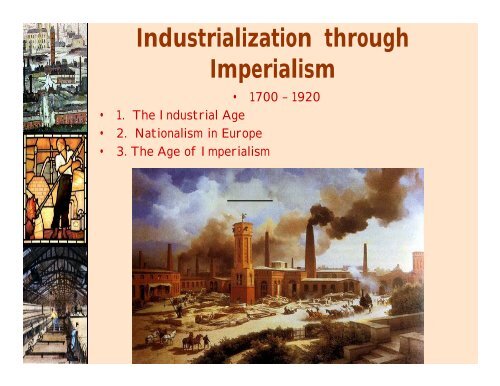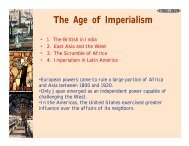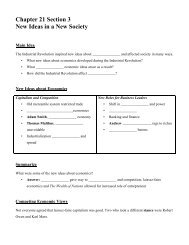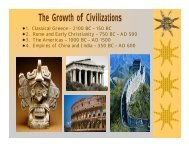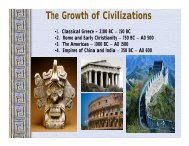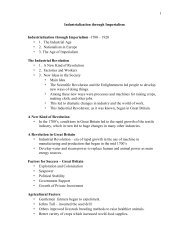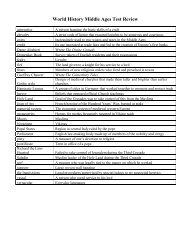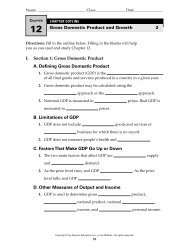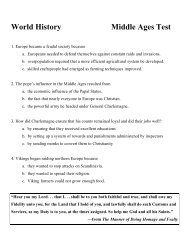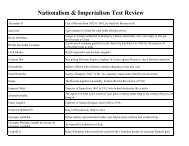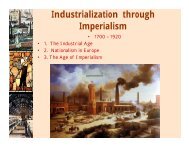The Industrial Revolution
The Industrial Revolution
The Industrial Revolution
You also want an ePaper? Increase the reach of your titles
YUMPU automatically turns print PDFs into web optimized ePapers that Google loves.
<strong>Industrial</strong>ization through<br />
Imperialism<br />
• 1700 – 1920<br />
• 1. <strong>The</strong> <strong>Industrial</strong> Age<br />
• 2. Nationalism in Europe<br />
• 3. <strong>The</strong> Age of Imperialism
1700 -1920<br />
<strong>The</strong> <strong>Industrial</strong> <strong>Revolution</strong><br />
• 1. A New Kind of <strong>Revolution</strong><br />
• 2. Factories and Workers<br />
• 3. New Ideas in the Society<br />
•<strong>The</strong> Scientific <strong>Revolution</strong> and the Enlightenment<br />
led people to develop new ways of doing things.<br />
•Among these new ways were processes and<br />
machines for raising crops, making cloth, and other<br />
jobs.<br />
•This led to dramatic changes in industry and the<br />
world of work.<br />
•This <strong>Industrial</strong> <strong>Revolution</strong>, as it was known, began<br />
in Great Britain.
1. A New Kind of <strong>Revolution</strong><br />
1700 -1920<br />
• In the 1700’s, conditions in Great Britain led to the rapid<br />
growth of the textile industry, which in turn led to huge<br />
changes in many other industries.
A <strong>Revolution</strong> in Great Britain<br />
• <strong>Industrial</strong> <strong>Revolution</strong> – era of rapid growth in the use of<br />
machine in manufacturing and production that began in<br />
the mid 1700’s<br />
• Develop water and steam power to replace human and<br />
animal power as main energy sources.<br />
1700 -1920
Factors for Success – Great<br />
Britain<br />
• Exploration and Colonization<br />
• Sea power<br />
• Political Stability<br />
• Government Support<br />
• Growth of Private Investment<br />
1700 -1920
1700 -1920<br />
Agricultural Factors<br />
• Gentlemen farmers began to<br />
experiment.<br />
• Jethro Tull – invented the<br />
seed drill<br />
• Others improved livestock<br />
breeding methods to raise<br />
healthier animals.<br />
• Better variety of crops which<br />
increased world food supplies.<br />
• Enclosure movement – allowed<br />
for more efficient farming<br />
methods and increased food<br />
supply – large fenced in farms
1700 -1920<br />
Britain’s Big Advantage<br />
• Great Britain had all the essential elements that a nation<br />
needed to achieve economic success.<br />
• Factors of Production – land, labor, and capital<br />
That Nation of Shopkeepers! -- Napoleon Bonaparte
A <strong>Revolution</strong> in Textiles<br />
• Cottage industry – a craft occupation performed in the home<br />
• Weaving – cottage industry – began the <strong>Industrial</strong> <strong>Revolution</strong><br />
(cloth making or textiles)<br />
• <strong>Industrial</strong>ization – process of changing to power driven<br />
machinery<br />
1700 -1920
A New Way of Cloth<br />
1700 -1920<br />
• A influx of cotton from the Americas due to the slave labor in<br />
the southern states.<br />
• As Great Britain needed more cotton, slavery became even<br />
more entrenched (economic reason that led to civil war)<br />
• Eli Whitney – Cotton Gin<br />
• Richard Arkwright – Spinning Frame – used to spin stronger,<br />
thinner thread<br />
• New Machines were far to big to remain in cottages and it led<br />
to factories – a building that housed industrial machines
Steam Power for <strong>Revolution</strong><br />
1700 -1920<br />
• Physics – when water is heated and changed into steam,<br />
it expands.<br />
• Use steam to harness power to drive machines – changed<br />
the world
<strong>The</strong> Steam Engine<br />
1700 -1920<br />
• England – 1712 – James Watt –first steam engine to drive<br />
machinery<br />
• Led to a power source for ships –Robert Fulton – the first<br />
steam engine ship – Clermont<br />
• Used on the Hudson River – Albany to NYC
Coal for British Steam Engines<br />
1700 -1920<br />
• Early steam was<br />
fueled by burning<br />
wood from<br />
England’s forest<br />
• New fuel – coal –<br />
the increase in<br />
factories built to<br />
run on steam led to<br />
a coal mining<br />
industry in England<br />
– produced 80% of<br />
Europe’s coal
1700 -1920<br />
<strong>Industrial</strong>ism Spreads<br />
• <strong>Industrial</strong>ization increased rapidly and spread to<br />
western Europe and the United States.<br />
• Asia and Africa – industrialized in 1800’s during age of<br />
imperialism<br />
• Individual freedom on economic activity led to<br />
increased industrialization in western Europe.
Industry Comes to America<br />
1700 -1920<br />
• <strong>The</strong> United States, because of its economic relationship with<br />
Great Britain, was one of the first to benefit from England’s<br />
industrialization.<br />
• Alexander Hamilton – Secretary of Treasury under George<br />
Washington – argued that industrialization would help the<br />
United States.<br />
• Samuel Slater, a highly skilled mill worker from Great Britain,<br />
traveled to the United States to make a fortune.<br />
• Textile mill industry spread throughout northeast United<br />
States – Lowell mills
Industry Spreads to Europe<br />
• William Cockerill, an engineer from Great Britain brought<br />
industry to continental Europe.<br />
1700 -1920<br />
• Went to Belgium, which was the second industrialized nation to<br />
develop in Europe.<br />
• Delayed in France (French <strong>Revolution</strong> and Napoleonic Wars) and<br />
in Germany (no central government)
1700 -1920<br />
Industry in Asia<br />
• Eventually industrialization spread to Asia.<br />
• Came to Japan fairly late, but today Japan is one of the<br />
world’s industrial leaders.
1700 -1920<br />
2. Factories and Workers<br />
• <strong>The</strong> transition from cottage industries changed how<br />
people worked in factories and labor conditions in the<br />
factories.
Production before Factories<br />
1700 -1920<br />
• Production began with the cottages and increased due to<br />
the factories.
1700 -1920<br />
Cottage Industries<br />
• Benefits – controlled work schedule, product quality<br />
guaranteed, made own decisions, and created own work season.<br />
• Disadvantages – fire or floods in your home caused from<br />
machines, homes are too small,<br />
• As a result moves towards factories, which in turn led to<br />
factory towns
Factories and Factory Towns<br />
• A factory laborer had to leave his or her home and work in place<br />
built especially for an industry.<br />
• Meant support for the family, but caused real hardship.<br />
• Working in the Factory –<br />
• Divided into several separate, easily learned tasks<br />
• Children worked in the factories to help with expenses<br />
• Working conditions were very poor - lack of ventilation, poor<br />
sanitation<br />
• Long hours, little pay<br />
• Public recognized need to improve working conditions<br />
1700 -1920
1700 -1920<br />
Life in Factory Towns<br />
• Factories changed not<br />
only the lives of the<br />
workers, but also towns<br />
where they were located.<br />
• Early towns centered<br />
around rivers to harness<br />
power for the steam<br />
engines; also centered<br />
around coal mines<br />
• This in turn led to<br />
unsanitary living<br />
conditions in the towns –<br />
overpopulated and<br />
pollution – which led to a<br />
need to improve cities<br />
Age of<br />
Worker<br />
Male<br />
Wages<br />
Female<br />
Wages<br />
under 11 2s 3d. 2s. 4d.<br />
11 - 16 4s. 1d. 4s. 3d.<br />
17 - 21 10s. 2d. 7s. 3d.<br />
22 - 26 17s. 2d. 8s. 5d.<br />
27 - 31 20s. 4d. 8s. 7d.<br />
32 - 36 22s. 8d. 8s. 9d.<br />
37 - 41 21s. 7d. 9s. 8d.<br />
42 - 46 20s. 3d. 9s. 3d.<br />
47 - 51 16s. 7d. 8s. 10d.<br />
52 - 56 16s. 4d. 8s. 4d.<br />
57 - 61 13s. 6d. 6s. 4d.
1700 -1920<br />
<strong>The</strong> Factory System and<br />
Workers<br />
• Factories changed transformed the nature of labor.<br />
• Factories required large amounts of capital – money to<br />
pay for building the buildings<br />
• Led to wealthy people investing in business or industries<br />
to make profits.
Cottage Workers’ Unrest<br />
1700 -1920<br />
• Faced a particular challenge caused by the factory<br />
system.<br />
• Cottage workers could not compete with factories, and<br />
facing ruins, some of these workers turned to violence.<br />
• Luddites Movement – people who resisted using the day’s<br />
technologies because it put them out of work
Changing Working Conditions<br />
1700 -1920<br />
• <strong>The</strong> British government took a hands off approach to the<br />
workers unrest and did nothing to regulate business.<br />
• Because government took no action, this led to labor<br />
unions – organizations that represent workers’ interests<br />
• To urge employers to create better working conditions,<br />
less hours, higher pay, they turned to strikes – work<br />
stoppages<br />
• Parliament got involved and eventually banned unions and<br />
strikes, but did pass laws to protect worker’s interests.
A New Class of Workers<br />
1700 -1920<br />
• Factor work led to the growth of the middle class.<br />
• Managers and accountants kept the factories running<br />
and their books balanced. Engineers designed the<br />
machines and maintained them.
1700 -1920<br />
Factories and Mass Production<br />
• Factories changed the world of work and led to a massive<br />
increase in production.<br />
• Mass Production – system of manufacturing large numbers of<br />
identical items.<br />
• Interchangeable parts – identical machine made parts – mad e<br />
production and repair more efficient.<br />
• Assembly Line – Product moves from worker to worker, as each<br />
one performs a step in the manufacturing process.
Effects of Mass Production<br />
• Advantages – dramatic increase in production<br />
• Disadvantage – led to repetitious jobs<br />
• Factory work became the norm in manufacturing.<br />
1700 -1920
3. New Ideas in a New Society<br />
• <strong>The</strong> <strong>Industrial</strong> <strong>Revolution</strong> inspired new ideas about<br />
economic and affected society in many ways.<br />
1700 -1920
New Ideas about Economics<br />
1700 -1920<br />
• 1700’ and 1800’s - industrialization changed not only the<br />
way people lived, but also they way people thought about<br />
making money.<br />
• MERCANTILISM
1700 -1920<br />
New Roles for Business Leaders<br />
• Capitalism – thrives in England and led to theory that government<br />
should not interfere. Private ownwership<br />
• Laissez-faire – little government interference in a nation’s economy.<br />
• Adam Smith – <strong>The</strong> Wealth of Nations - markets free from government<br />
interference benefited all.<br />
• Thomas Malthus – population growth caused by the development of<br />
industry<br />
• Entrepreneur – someone who starts a new business<br />
– Andrew Carnegie – American steel industry<br />
– Cornelius Vanderbuilt – Railroad industry<br />
– John D. Rockefeller – Standard Oil
Competing Economic Views<br />
• Not everyone agreed that capitalism was the best<br />
economic system<br />
• Robert Owen – Socialism – government should own<br />
property, not the people (economic)<br />
1700 -1920<br />
• Karl Marx – more radical view – communism – government<br />
should own and control all factors of production<br />
(political)
1700 -1920<br />
Effects on Society<br />
• <strong>The</strong> rise of economic ideas was among the countless<br />
effects the industrial revolution had on society.<br />
• Shift to factory work transformed the everyday lives of<br />
men and women.<br />
• Men had to go to work in the factories, and women had<br />
to stay home and tend to the children. ‘Separate<br />
Spheres”
1700 -1920<br />
Effects on Countries<br />
• On a larger scale than home life, the industrial<br />
revolution also affected entire countries.<br />
• Europe –Great Britain, France, and Germany –leaders in<br />
the global market<br />
• <strong>The</strong> United States became an industrial super power.
1700 -1920<br />
Long-Term Effects on Societies<br />
• Increased standard of living – level of material comfort<br />
for people in industrialized nations.


